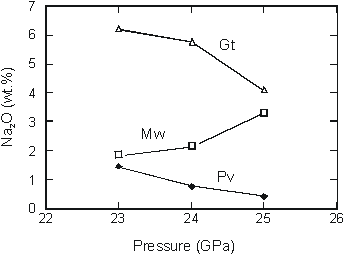

Multi-anvil melting experiments at pressures between 16 and 25 GPa and temperatures of 1800-2100oC have been conducted in order to investigate possible alkali fractionation in the early primitive Earth's lower mantle. A sample of M'bale L6 chondrite with additional Na2O and K2O (3 times the original meteorite content) was used as a starting material. The Na2O/K2O ratio was 7 in the starting material and the Mg# (Mg# = MgO/(MgO+FeO)) was 0.73. Melting experiments were performed for between 5 and 20 minutes in Re capsules and the quenched samples were analysed using electron microprobe and Raman spectroscopy.
In experimental charges garnet and magnesiowüstite were found above the solidus temperature at pressures from 21 to 25 GPa. Above 23 GPa silicate perovskite and K-hollandite were also found above the solidus. The abundance of garnet in the runs decreases from 21 to 25 GPa, whereas the abundance of silicate-perovskite increases with increasing pressure from 23 to 25 GPa. The abundance of magnesiowüstite remains fairly constant over the pressure range studied. As shown in Figure 3.3-21, Na2O contents of both garnet and
 |
perovskite decrease with pressure, while the Na2O content of magnesiowüsite increases. Between 21 and 25 GPa the K2O-contents of silicate-perovskite, garnet and magnesiowüstite are very low (less than 0.1 wt.%), although the bulk starting material contains 0.4 wt.% K2O.
The results indicate that the phases garnet, magnesiowüstite and perovskite are likely to be the major carriers of sodium in the mantle at pressures between 21 and 25 GPa. Na-concentrations in garnet and perovskite decrease with increasing pressure, but the capacity for magnesiowüstite to contain Na seems to increase with pressure. Magnesiowüstite may therefore become the major host for Na in the deep mantle (Fig. 3.3-21). Silicate-perovskite, garnet and magnesiowüstite do not, however, contain significant K. Below 23 GPa K is partitioning into the silicate melt phase and above 23 GPa it is present mainly in K-hollandite. We did, however, find some very tiny K-rich phases often as inclusions in other minerals. Many of these spots were less than 3 µm and too small for quantitative microprobe analysis and phase identification. We are currently investigating these small grains. The results of this study suggest that during crystallisation of a magma ocean at the top of the lower mantle, Na would be removed from the melt by garnet and magnesiowüsite while crystallisation of K-hollandite would remove K. This raises the possibility that differential settling of these various minerals could have led to K and Na fractionation in the early mantle.

Tel: +49-(0) 921 55 3700 / 3766, Fax: +49-(0) 921 55 3769, E-mail: bayerisches.geoinstitut(at)uni-bayreuth.de
 Previous page
Previous page